#NEXUSat50 1982 PLAYING WITH POETRY We spent 3 days at Toronto’s McClear Place with 78-year-old poet Earle Birney, recording a 3 volume set. Released in LP and audio cassette format, they have never been re-issued as CDs, but 2 of the poems were included in our lat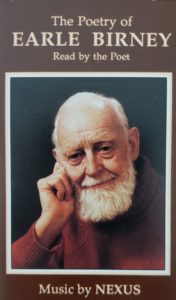 er “The Best of NEXUS” CD.
er “The Best of NEXUS” CD.
We had begun performing with Earle 10 years before. Earle had twice won the Governor General’s Award, Canada’s top literary honour. Born in Alberta, raised on a farm in British Columbia, he had worked as a farm hand, bank clerk and park ranger, planned to study chemical engineering but instead graduated with a degree in English, studied at 4 universities, started teaching at age 42, and then established Canada’s first Department of Creative Writing at UBC.
Warren Benson had met Earle in 1962 through a friend in Mexico. Ever the catalyst, Benson introduced us to Earle and suggested we collaborate. Debra Waugh in her 2007 thesis writes of our 1973 performance at York University, Toronto: “[Warren] Benson described one such performance in which he participated with NEXUS accompanying the renowned Canadian poet Earle Birney: ‘he [Birney] was reading one [poem]. . . . And right in the middle of it, without a cue . . . we’re all playing My Fair Lady in different parts.’ The members [of NEXUS] were so open to ideas and sounds around them that it was almost as though their different minds thought for a moment as one. Dialogic theorists would argue that it is impossible for this to happen . . . . ”
An article by Ted Shaw in the Windsor Star in Oct’83 sheds light on our process: “About 50 years ago, a young sailor, Earle Birney, wrote a dreadful sonnet about the Northwest Passage that he quickly forgot. It would be 4 decades or more that Alaska Passage collected dust in Birney’s pile of discarded verse until a Toronto-based modern percussion group, NEXUS, prompted him to dig it up…[Birney] took the sonnet and altered its rhythmic structure. What is left is the chant-like image of a swaying ship in brutal northern seas, called ‘Alas-ka passage ALAS-KA pass’… Birney’s dramatic poems are accompanied by NEXUS, creating an aural painting….His observations of Canadian life are often hilarious, his love poems make you blush and his sarcasm is sharp-witted. The development of ‘Alaska Passage’, originally written in 1934, parallels the way some of Birney’s other works have been transformed rhythmically since he agreed to collaborate with NEXUS 10 years ago. ‘They use poems already written,’ said Birney, ‘and they, improvise. I don’t improvise when I’m reading them, but (the performances) affect me eventually. I learn things about the poetry, like rhythmic effect and tone quality.’ ”
Bob Becker comments: “I think many of us in NEXUS were inspired by Earle Birney’s poetry. I have several collections of his work, and I often read the poems he selected to perform together with us on concerts. I even memorized a couple of the shorter ones. I first learned about Earle through a piece written by my composition teacher Warren Benson titled “Nara”. Warren’s piece…was composed in 1968 while I was studying with him. The final movement of the work is a setting of Birney’s poem “Wind-Chimes in a Temple Ruin.” John Wyre and Robin Engelman were the percussionists for the premiere of “Nara” at Canada’s Shaw Festival. When we began to collaborate with Earle, NEXUS simply listened to his recitation and improvised in real-time in response to his words. He had a distinctive voice and a dramatic, expressive way of speaking. As we continued to work together, a few poems suggested musical formats that we could work within, although our approach to most of them remained spontaneous. For example, his “Never Blush to Dream” had been in fact written as lyrics to Scott Joplin’s “Chrysanthemum Rag”. I arranged two strains from Joplin’s piece for marimbas and glockenspiel, and we played it as Earle more or less “sang” his poem….Once when Earle was reading his extended poem “Sestina for the Ladies of Teháuntepec”, I began to improvise some chord changes on vibraphone, and that led to a repetitive structure that we continued to use on our concerts. The poem “McSimpton’s annual boat excursion to Nanaimo, June 1949” contains numerous references to songs that were popular during the 1940s, such as There’s A Long, Long Trail, and Oh, Dem Golden Slippers. Of course, Earle invented new lyrics for each song, with kind of crazy results. I played piano on this one, and since I’m a hack on the instrument, my versions fit the mood of a raucous family outing on a rocking boat. A few other poems suggested certain instrumentations, either because of a strongly evocative mood such as in “Alaska Passage”, or an implied narrative as in “From Swindon to London by Britrail Aloud.”
Read more: – “Nexus: Integrating Musical Traditions” by Debra Waugh, her Ph.D Thesis (Univ. of Hong Kong 2007).
- Full Windsor Star article: Oct. 15, 1983. © Excerpts reprinted courtesy of the Windsor Star
- The photo of Earle on the audio cassette liner is by Bela Baliko
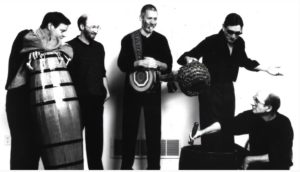
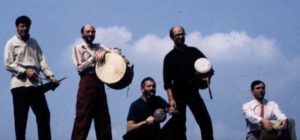
NEXUS on Hampstead Heath
#NEXUSat50 1982 UK, REICH and – HONEY BEARS? June’82 took us to Tanglewood, our first solo concert there. Abraham Adzenyah joined us and it was a resounding success. In Winnipeg we had an opportunity to perform Bill’s lovely piece “In Ancient Temple Gardens” and John Wyre’s new work, his affecting “Cloches pour Michel” with the symphony orchestra under the baton of Victor Yampolsky. Bob Becker also had a new work “Palta” which he describes as “a kind of concerto for the North Indian tabla accompanied by traditional western percussion instruments.” It was part of our repertoire for another whirlwind UK tour: over 17 British concerts in 19 days – some days were school concerts (plural). We had begun this tour at the Varése Conservatory in Paris and we ended with an appearance in Cardiff, Wales. Hard on the tour’s heels, we were in Symphony Space NYC, then 3 appearances in Washington DC including the Cage Celebration at the Kennedy Center, and a couple days later we were introducing Steve Reich’s music to the percussion world at PASIC’82 in Dallas. For the first time, Steve performed along with NEXUS on this program! But no discussion of 1982 would be complete without mentioning the OUTDOOR concert booked for a February EVENING at Ottawa’s winter festival “Winterlude ‘82” on Dow’s Lake in the heart of the city. Do you know Ottawa? In February? The average high is -3.4°C (25.9°F), while the average low is -12.7°C (9.1°F). The lake was surrounded by sparkling ice sculptures. We had opted for our group composition titled “Chamber Music”, normally performed in black business suits. In “Unpopular Music”, you can read Bill’s wonderful description of this piece, which we had premiered at Toronto Free Theatre in Sept’81. In summary, “Chamber Music” involved mime, small instruments, a candelabra, a tam-tam (fortissimo), and 5 pistols – “On the whole,” says Bill Cahn in sublime understatement, “a pretty effective piece.” Only this time, “we dressed ourselves in large rented honey-bear costumes, the kind with brown fur and pull-over face masks. As we walked onto the stage we realized it was really hard to see out of honey-bear masks,” not to mention manoeuvring. But the costumes were amazingly warm. Bill says, “I was able to see out into the array of smiles on the faces of the kids and parents…and everyone seemed to eagerly and willingly accept the sight of five honey-bears shooting pistols into the icy air as if it were the most natural of occurrences.”
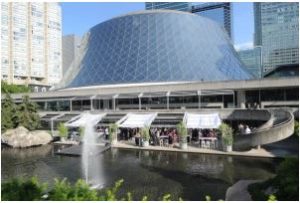 #NEXUSat50 1982 INTERESTING SIDELIGHT Toronto’s beautiful new concert venue, Roy Thomson Hall, opened in spring 1982. John Wyre received a formal invitation for NEXUS to participate in the acoustic test. All five of us were there. Bill recalls playing “The Downfall of Paris” (part of our “Ancient Military Aires”). Bob recalls playing “Tongues” (mbira) and playing a bass drum for the lows and a xylophone for the highs. Russell recalls playing gankoguis (African bells) and spacing ourselves apart from one another to see if we could hear across the stage. He wryly adds, “We may also have played Music for Pieces of Wood socially distanced.” As Bill says, “In the euphoria of a new hall, we were initially very impressed with the building and its acoustics. Over time, however, if any acoustic defects exist, they will eventually make themselves known.” Bob agrees: “Definitely there was enthusiasm for the sound of the new hall by individuals and small ensembles. Some deficiencies later became obvious to the TSO and many conductors, and that led to the acoustic make-over in 2002.” You can read the details of that makeover in a Globe & Mail article of 2002, here.
#NEXUSat50 1982 INTERESTING SIDELIGHT Toronto’s beautiful new concert venue, Roy Thomson Hall, opened in spring 1982. John Wyre received a formal invitation for NEXUS to participate in the acoustic test. All five of us were there. Bill recalls playing “The Downfall of Paris” (part of our “Ancient Military Aires”). Bob recalls playing “Tongues” (mbira) and playing a bass drum for the lows and a xylophone for the highs. Russell recalls playing gankoguis (African bells) and spacing ourselves apart from one another to see if we could hear across the stage. He wryly adds, “We may also have played Music for Pieces of Wood socially distanced.” As Bill says, “In the euphoria of a new hall, we were initially very impressed with the building and its acoustics. Over time, however, if any acoustic defects exist, they will eventually make themselves known.” Bob agrees: “Definitely there was enthusiasm for the sound of the new hall by individuals and small ensembles. Some deficiencies later became obvious to the TSO and many conductors, and that led to the acoustic make-over in 2002.” You can read the details of that makeover in a Globe & Mail article of 2002, here.
Postscript: In delving through scrapbooks, Bill Cahn found the Roy Thomson test programme! Here is what we played that day: Fantasy on “The Downfall of Paris” – NEXUS. Music for Pieces of Wood – Reich. Bell Pairings – NEXUS. Fluffy Ruffles – G.H.Green/arr. Cahn. Dill Pickles – C.Johnson/arr. Becker. Xylophonia – Joe Green/arr. Cahn
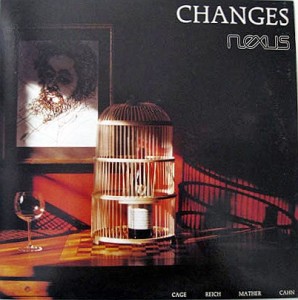 #NEXUSat50 1982 CHANGES Having lost Michael Craden at the beginning of 1982, we ended the year releasing an LP entitled “Changes”. The album featured “Third Construction” (John Cage), “Music For Pieces of Wood” (Steve Reich), our first-ever commission “Clos De Vougeot” by Bruce Mather, and a piece by Bill Cahn entitled “Changes”. The front cover of the album features a self-portrait by Michael drawn in ink. Bob Becker and Robin Engelman did the set-up for the cover shot in Robin’s living room when Robin lived in King City north of Toronto. Beside the portrait of Michael, you will see a bottle Clos de Vougeot (1964 – a truly great year!) and a wooden birdcage.
#NEXUSat50 1982 CHANGES Having lost Michael Craden at the beginning of 1982, we ended the year releasing an LP entitled “Changes”. The album featured “Third Construction” (John Cage), “Music For Pieces of Wood” (Steve Reich), our first-ever commission “Clos De Vougeot” by Bruce Mather, and a piece by Bill Cahn entitled “Changes”. The front cover of the album features a self-portrait by Michael drawn in ink. Bob Becker and Robin Engelman did the set-up for the cover shot in Robin’s living room when Robin lived in King City north of Toronto. Beside the portrait of Michael, you will see a bottle Clos de Vougeot (1964 – a truly great year!) and a wooden birdcage.
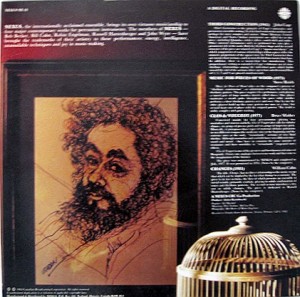 Bob Becker explains that this is “a weird reference to John Cage, whose “Third Construction” is on the album, and to Reich’s “Music for Pieces of Wood”, as the cage is made of wooden sticks.” The album’s title “Changes” refers to Michael’s passing of course but is also the title of Bill Cahn’s piece included on the recording. The piece is published by HoneyRock Publishing and is in two sections, the first an ensemble of metal sounds (primarily cymbals) in subtle combinations, and the second “introduces a few not-so-subtle changes” brought about by bike horn, flexatone, popgun, cowbell, wood block, fire bell and anvil.
Bob Becker explains that this is “a weird reference to John Cage, whose “Third Construction” is on the album, and to Reich’s “Music for Pieces of Wood”, as the cage is made of wooden sticks.” The album’s title “Changes” refers to Michael’s passing of course but is also the title of Bill Cahn’s piece included on the recording. The piece is published by HoneyRock Publishing and is in two sections, the first an ensemble of metal sounds (primarily cymbals) in subtle combinations, and the second “introduces a few not-so-subtle changes” brought about by bike horn, flexatone, popgun, cowbell, wood block, fire bell and anvil.
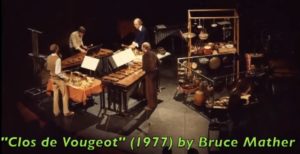
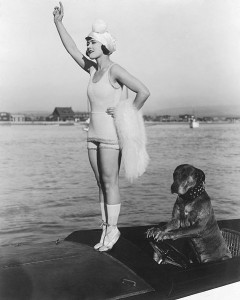 #NEXUSat50 1983 KEYSTONE TEDDY After the hectic pace of ‘82, things quieted down a bit. Not surprisingly following on our 3 vol. album release with Earle Birney, we had engagements with him, and a couple of March residencies at Wichita State (Kansas) and Drake (Iowa). We had an opportunity to perform John Wyre’s “Cloches pour Michel” with Paul Robinson’s CJRT Festival Orchestra, Toronto. As conductor of that orchestra, Robinson had become known for presenting the premieres of works by several Canadian composers. Robin, following his particular interest, brought in the idea of adding rudimental drum pieces to our repertoire and he and Bill created a suite that Robin called “Ancient Military Aires” – a stirring opener for any concert and one we still use today. Most fun was the addition to our repertoire of “Teddy at The Throttle”, Mack Sennett’s great 1916 silent film starring Gloria Swanson and Keystone Teddy, the dog who saves the girl tied to the railway tracks. This grew out of Bill Cahn’s connections to Eastman and the Rochester Philharmonic Orchestra and his recently-acquired library of several thousand orchestrations for theatre orchestra published between 1890 and 1930 (now owned by the Peacherine Ragtime Society Orchestra). A few years prior, Bill had met several times with the George Eastman House staff to find an appropriate film to commemorate the early days (1920s) when the Eastman Theatre Orchestra performed silent film accompaniments. (The ETO was the core orchestra of the RPO.) “Teddy” fit the bill (no pun intended). Bill selected musical accompaniment for the “silent” from his new library. “Teddy at the Throttle” was first performed by the RPO ca.1980 at a special patrons concert in the Dryden Theatre at the George Eastman House in Rochester. Immediately after that first performance, Bill found and purchased his own copy of the film and programmed Teddy with his own Rochester Theatre Orchestra. He adapted/arranged the piece for NEXUS and in 1983 we performed it twice – at Mount Allison University in New Brunswick and at Walter Hall in Toronto. We would perform it again in January’84 for a Rochester Philharmonic Pops Concert with Bill conducting. “Teddy” was later used as the finale for our “From Rags to Riches” family/pops concert. Wallace Beery is the villain of the piece, trying to get his hands on Gloria Swanson’s inheritance. The action builds to the point where it’s “on track”, and then it’s Teddy to the rescue! As our promo blurb says, “A hilarious and exhilarating accompaniment to the silent film – with authentic sound effects has Nexus fronting a ‘pit orchestra’ for a truly Grand Finale!” Some of the pieces that Bill arranged for “Teddy” are “The Wizard of the Nile” (1896) by Victor Herbert, “Dainty Dames” (1915) by Charlotte Blake, “Cupid’s Garden” (1901) by Max C. Eugene, “Zephyr” (1916) by George J. Trinkhaus, and “Photoplay” generic film music (ca. 1915) composed by Ernst Luz.
#NEXUSat50 1983 KEYSTONE TEDDY After the hectic pace of ‘82, things quieted down a bit. Not surprisingly following on our 3 vol. album release with Earle Birney, we had engagements with him, and a couple of March residencies at Wichita State (Kansas) and Drake (Iowa). We had an opportunity to perform John Wyre’s “Cloches pour Michel” with Paul Robinson’s CJRT Festival Orchestra, Toronto. As conductor of that orchestra, Robinson had become known for presenting the premieres of works by several Canadian composers. Robin, following his particular interest, brought in the idea of adding rudimental drum pieces to our repertoire and he and Bill created a suite that Robin called “Ancient Military Aires” – a stirring opener for any concert and one we still use today. Most fun was the addition to our repertoire of “Teddy at The Throttle”, Mack Sennett’s great 1916 silent film starring Gloria Swanson and Keystone Teddy, the dog who saves the girl tied to the railway tracks. This grew out of Bill Cahn’s connections to Eastman and the Rochester Philharmonic Orchestra and his recently-acquired library of several thousand orchestrations for theatre orchestra published between 1890 and 1930 (now owned by the Peacherine Ragtime Society Orchestra). A few years prior, Bill had met several times with the George Eastman House staff to find an appropriate film to commemorate the early days (1920s) when the Eastman Theatre Orchestra performed silent film accompaniments. (The ETO was the core orchestra of the RPO.) “Teddy” fit the bill (no pun intended). Bill selected musical accompaniment for the “silent” from his new library. “Teddy at the Throttle” was first performed by the RPO ca.1980 at a special patrons concert in the Dryden Theatre at the George Eastman House in Rochester. Immediately after that first performance, Bill found and purchased his own copy of the film and programmed Teddy with his own Rochester Theatre Orchestra. He adapted/arranged the piece for NEXUS and in 1983 we performed it twice – at Mount Allison University in New Brunswick and at Walter Hall in Toronto. We would perform it again in January’84 for a Rochester Philharmonic Pops Concert with Bill conducting. “Teddy” was later used as the finale for our “From Rags to Riches” family/pops concert. Wallace Beery is the villain of the piece, trying to get his hands on Gloria Swanson’s inheritance. The action builds to the point where it’s “on track”, and then it’s Teddy to the rescue! As our promo blurb says, “A hilarious and exhilarating accompaniment to the silent film – with authentic sound effects has Nexus fronting a ‘pit orchestra’ for a truly Grand Finale!” Some of the pieces that Bill arranged for “Teddy” are “The Wizard of the Nile” (1896) by Victor Herbert, “Dainty Dames” (1915) by Charlotte Blake, “Cupid’s Garden” (1901) by Max C. Eugene, “Zephyr” (1916) by George J. Trinkhaus, and “Photoplay” generic film music (ca. 1915) composed by Ernst Luz.
#NEXUSat50 1983 RAIN TREE by Toru Takemitsu became an important part of our repertoire in 1983. Bob talked about it in a 2003 conversation with @Ed Choi: “With NEXUS, I have always played the vibraphone/crotale part. When we first began playing the piece, I used to play the solo part at the beginning in fairly strict tempo – I felt that the cross-rhythmic effect was really great and I wanted to make it clear. I applied the “freely” marking more to dynamic phrasing… Takemitsu heard NEXUS play the work a number of times, and he never said anything either way about how I played that particular section. Later, I began to take more liberties with every aspect of that part of the piece – mostly from a desire to explore further something I’ve played so often…once you learn to play the rhythms accurately in tempo, it’s fairly easy to be expressive with the phrasing….I have two sets of the low A and B crotales that are required for Rain Tree. The older set I ordered from Kolberg in Germany – at great expense – when NEXUS started touring with the piece. They sucked when I got them and they still sound like crap. Robin refused to play the low A. I ordered a second set from Sabian a few years ago. They are much better, but still not perfect. Nick Petrella has been trying to convince Sabian to market these pitches specifically because of Rain Tree, but so far they would still be a special order. Once you work up a part like the vibraphone in Rain Tree, it’s a good investment to purchase those two crotales so that you can continue to play the piece anywhere in the future… I use a custom set of vibes mallets for most of the piece – basically the old Malletech Friedman mallets before they changed to the softer design – with extra-long shafts. These mallets are rather hard and bright…In NEXUS, the marimba players always played the crotales with my blue xylo mallets (BB34s), and the crotale sound matched up pretty well between the vibes part and the marimba parts, even when I was using a wrapped mallet….”
You can read more details on Bob’s mallet choices in his blog post on questions about Rain Tree at https://www.nexuspercussion.com/2009/02/answers-to-questions-about-rain-tree-by-toru-takemitsu/ Bob ends his conversation with Ed saying, “I’m sure you’ll find your own way around the piece. Have a great time with it – it’s a wonderful experience.”
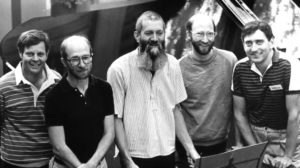 #NEXUSat50 1983 STRANGE FRAGRANT OILS In June we performed John Wyre’s “Connexus” once again with the Toronto Symphony and Maestro Andrew Davis. The Toronto Star review was beautiful: “Hard to believe, but it was actually the contemporary piece on last night’s Toronto Symphony program that drew the cheers. Deservedly. The work was NEXUS drummer John Wyre’s ‘Connexus’…Like being bathed in strange, fragrant oils.” At about this time, we also introduced a new piece composed by @BillCahn, “Kebjar-Bali” (pronounced, keb-yar bah-li). Both it and Bill’s “In Ancient Temple Gardens” were originally conceived as pieces for percussion soloist with chamber orchestra, and were later arranged for NEXUS, either with orchestra or unaccompanied. The first performances of both of Bill’s pieces were with the Rochester Chamber Orchestra, conducted by David Fetler. “Kebjar-Bali” is based on the traditional music of Bali, which is normally performed by a Gamelan orchestra – comprised of as many as 25 musicians playing on various tuned gongs, drums, cymbals, xylophones, metallophones, and other percussion instruments along with flutes and a few string instruments. NEXUS utilizes for the piece a number of tuned gongs from southeast Asia and standard western mallet percussion instruments – marimbas, a vibraphone, and two sets of songbells (alto glockenspiels). The term “Kebjar” refers to a twentieth-century Balinese musical style. The word literally means “to burst into flame”, and this is represented in the music by highly technical and rhythmically intricate passages which are interspersed with sections in a more stately style. You can enjoy excerpts from both “Connexus” and “Kebjar-Bali” here.
#NEXUSat50 1983 STRANGE FRAGRANT OILS In June we performed John Wyre’s “Connexus” once again with the Toronto Symphony and Maestro Andrew Davis. The Toronto Star review was beautiful: “Hard to believe, but it was actually the contemporary piece on last night’s Toronto Symphony program that drew the cheers. Deservedly. The work was NEXUS drummer John Wyre’s ‘Connexus’…Like being bathed in strange, fragrant oils.” At about this time, we also introduced a new piece composed by @BillCahn, “Kebjar-Bali” (pronounced, keb-yar bah-li). Both it and Bill’s “In Ancient Temple Gardens” were originally conceived as pieces for percussion soloist with chamber orchestra, and were later arranged for NEXUS, either with orchestra or unaccompanied. The first performances of both of Bill’s pieces were with the Rochester Chamber Orchestra, conducted by David Fetler. “Kebjar-Bali” is based on the traditional music of Bali, which is normally performed by a Gamelan orchestra – comprised of as many as 25 musicians playing on various tuned gongs, drums, cymbals, xylophones, metallophones, and other percussion instruments along with flutes and a few string instruments. NEXUS utilizes for the piece a number of tuned gongs from southeast Asia and standard western mallet percussion instruments – marimbas, a vibraphone, and two sets of songbells (alto glockenspiels). The term “Kebjar” refers to a twentieth-century Balinese musical style. The word literally means “to burst into flame”, and this is represented in the music by highly technical and rhythmically intricate passages which are interspersed with sections in a more stately style. You can enjoy excerpts from both “Connexus” and “Kebjar-Bali” here.
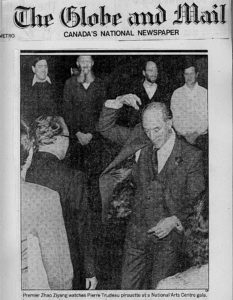 1984 DANCING WITH THE STARS @BillCahn tells this tale: “In January 1984 NEXUS observed the Prime Minister of Canada, Pierre Trudeau as he strutted his stuff to Zhao Ziyang, the Premier of the People’s Republic of China. The news photo that appeared in the Toronto Globe and Mail on January 17th was taken after a command performance by Canadian artists in honour of visiting Chinese Premier Zhao Ziyang at the National Arts Centre in Ottawa. The photo showed NEXUS standing wide-eyed behind the Prime Minister as he showed off by performing a daring pirouette. Trudeau had just finished greeting each of the artists, one-by-one, who were all standing in a post-concert reception line. He glared at each performer directly, eyeball-to-eyeball, with a deeply penetrating gaze, as he shook each one’s hand. Ziyang was reported as asking, in reply to Pierre Trudeau’s expressed concern about the harsh population control policies in China, if Trudeau would accept 10 or 20 million Chinese as a gift. End of discussion. It wasn’t very long afterwards (2 years?) that Zhao Ziyang ended up in prison in China for being too reformist. A few months after the National Arts Centre concert, in the summer of 1984, NEXUS would be the first western percussion ensemble to perform in China – Beijing and Shanghai – after the end of China’s ‘Cultural Revolution’.” The innocent onlookers in the news photo are L to R: Bill, John, Bob, Robin
1984 DANCING WITH THE STARS @BillCahn tells this tale: “In January 1984 NEXUS observed the Prime Minister of Canada, Pierre Trudeau as he strutted his stuff to Zhao Ziyang, the Premier of the People’s Republic of China. The news photo that appeared in the Toronto Globe and Mail on January 17th was taken after a command performance by Canadian artists in honour of visiting Chinese Premier Zhao Ziyang at the National Arts Centre in Ottawa. The photo showed NEXUS standing wide-eyed behind the Prime Minister as he showed off by performing a daring pirouette. Trudeau had just finished greeting each of the artists, one-by-one, who were all standing in a post-concert reception line. He glared at each performer directly, eyeball-to-eyeball, with a deeply penetrating gaze, as he shook each one’s hand. Ziyang was reported as asking, in reply to Pierre Trudeau’s expressed concern about the harsh population control policies in China, if Trudeau would accept 10 or 20 million Chinese as a gift. End of discussion. It wasn’t very long afterwards (2 years?) that Zhao Ziyang ended up in prison in China for being too reformist. A few months after the National Arts Centre concert, in the summer of 1984, NEXUS would be the first western percussion ensemble to perform in China – Beijing and Shanghai – after the end of China’s ‘Cultural Revolution’.” The innocent onlookers in the news photo are L to R: Bill, John, Bob, Robin
 #NEXUSat50 1984 KITTEN ON THE CONGAS That National Arts Centre Gala (see this morning’s post) was clearly momentous to many, including Simon Teakettle the cat. The story from manager Peggy Feltmate: “Every now and then we run into bloggers who are blogging about NEXUS. Most of these blog entries are written by human beings, but in 2009 we ran into one that was posted by a cat. His name was Simon Teakettle and his blog was called Between Naps. Clearly NEXUS fans come in all stripes or spots. Simon was quite an adept tambourine player (he said), with aspirations of taking up the bongos and other percussion. And that’s why Simon was blogging that he had sent a birthday request to CBC Radio, asking that they play a NEXUS piece for him (which they did). Apparently this was not Simon’s first NEXUS request. From Simon’s blog entry: ‘My requests for Nexus were so frequent on CBC in the early days that when [my owner] Bobbi met them, backstage at the National Arts Centre in Ottawa, they said the admiration was mutual! That was in January of 1984…. I’d like to meet them someday, and if they visit I promise to let them use all my drums, both tambourines, and even the cymbals, chimes and castanets!’ “
#NEXUSat50 1984 KITTEN ON THE CONGAS That National Arts Centre Gala (see this morning’s post) was clearly momentous to many, including Simon Teakettle the cat. The story from manager Peggy Feltmate: “Every now and then we run into bloggers who are blogging about NEXUS. Most of these blog entries are written by human beings, but in 2009 we ran into one that was posted by a cat. His name was Simon Teakettle and his blog was called Between Naps. Clearly NEXUS fans come in all stripes or spots. Simon was quite an adept tambourine player (he said), with aspirations of taking up the bongos and other percussion. And that’s why Simon was blogging that he had sent a birthday request to CBC Radio, asking that they play a NEXUS piece for him (which they did). Apparently this was not Simon’s first NEXUS request. From Simon’s blog entry: ‘My requests for Nexus were so frequent on CBC in the early days that when [my owner] Bobbi met them, backstage at the National Arts Centre in Ottawa, they said the admiration was mutual! That was in January of 1984…. I’d like to meet them someday, and if they visit I promise to let them use all my drums, both tambourines, and even the cymbals, chimes and castanets!’ “
